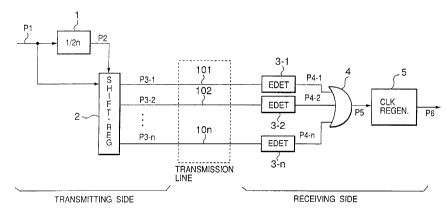Some of the information on this Web page has been provided by external sources. The Government of Canada is not responsible for the accuracy, reliability or currency of the information supplied by external sources. Users wishing to rely upon this information should consult directly with the source of the information. Content provided by external sources is not subject to official languages, privacy and accessibility requirements.
Any discrepancies in the text and image of the Claims and Abstract are due to differing posting times. Text of the Claims and Abstract are posted:
| (12) Patent: | (11) CA 2203725 |
|---|---|
| (54) English Title: | METHOD OF TRANSMITTING CLOCK SIGNAL AND DEVICE EMPLOYING THE SAME |
| (54) French Title: | METHODE DE TRANSMISSION DE SIGNAUX D'HORLOGE ET DISPOSITIF UTILISANT CETTE METHODE |
| Status: | Deemed expired |
| (51) International Patent Classification (IPC): |
|
|---|---|
| (72) Inventors : |
|
| (73) Owners : |
|
| (71) Applicants : |
|
| (74) Agent: | G. RONALD BELL & ASSOCIATES |
| (74) Associate agent: | |
| (45) Issued: | 2001-07-03 |
| (22) Filed Date: | 1997-04-25 |
| (41) Open to Public Inspection: | 1997-11-21 |
| Examination requested: | 1997-04-25 |
| Availability of licence: | N/A |
| (25) Language of filing: | English |
| Patent Cooperation Treaty (PCT): | No |
|---|
| (30) Application Priority Data: | ||||||
|---|---|---|---|---|---|---|
|
A frequency divider 1 on the transmitting side
divides the frequency of a clock signal of period T by 8,
generates a pulse signal P2 of pulse width 4T and duty
ratio 50%, and outputs the result to a shift register 2.
The shift register 2 generates pulse signals P3-1, P3-2,
P3-3, and P3-4 by giving delays 0, T, 2T, and 3T to the
pulse signal P2, and sends them to transmission lines
101, 102, 103, and 104, respectively. Edge detectors
3-1, 3-2, 3-3, and 3-4 on the receiving side detect
respectively the leading edges and the trailing edges
of the pulse signals P3-1, P3-2, P3-3, and P3-4, and
output edge detection signals P4-1, P4-2, P4-3, and P4-4.
An OR gate 4 combines these edge detection signals.
A clock regenerator 5 generates a regenerated signal P6
having the frequency equal to that of the clock signal P1
based on the combined edge detection signal P5.
Un diviseur de fréquence 1 incorporé à un émetteur divise la fréquence d'un signal d'horloge de période T par 8, produit une impulsion P2 de largeur 4T à rapport cyclique de 50 % et transmet le résultat à un registre à décalage 2. Celui-ci produit des impulsions P3-1, P3-2, P3-3 et P3-4 en produisant des retards de 0, T, 2T et 3T dans l'impulsion P2, et les transmet aux lignes de transmission 101, 102, 103 et 104 respectivement. Des détecteurs de flancs d'impulsion 3-1, 3-2, 3-3 et 3-4 incorporés au récepteur détectent respectivement les flancs avant et les flancs arrière des impulsions P3-1, P3-2, P3-3 et P3-4 et produisent des signaux de détection de flancs d'impulsion P4-1, P4-2, P4-3 et P4-4. Une porte OU 4 combine ces signaux de détection de flancs d'impulsion. Un régénérateur de signaux d'horloge 5 produit un signal d'horloge régénéré P6 dont la fréquence est égale à celle du signal d'horloge P1 en utilisant le signal combiné de détection de flancs d'impulsion P5.
Note: Claims are shown in the official language in which they were submitted.
Note: Descriptions are shown in the official language in which they were submitted.

For a clearer understanding of the status of the application/patent presented on this page, the site Disclaimer , as well as the definitions for Patent , Administrative Status , Maintenance Fee and Payment History should be consulted.
| Title | Date |
|---|---|
| Forecasted Issue Date | 2001-07-03 |
| (22) Filed | 1997-04-25 |
| Examination Requested | 1997-04-25 |
| (41) Open to Public Inspection | 1997-11-21 |
| (45) Issued | 2001-07-03 |
| Deemed Expired | 2003-04-25 |
There is no abandonment history.
| Fee Type | Anniversary Year | Due Date | Amount Paid | Paid Date |
|---|---|---|---|---|
| Request for Examination | $400.00 | 1997-04-25 | ||
| Registration of a document - section 124 | $100.00 | 1997-04-25 | ||
| Application Fee | $300.00 | 1997-04-25 | ||
| Maintenance Fee - Application - New Act | 2 | 1999-04-26 | $100.00 | 1999-04-16 |
| Maintenance Fee - Application - New Act | 3 | 2000-04-25 | $100.00 | 2000-04-20 |
| Final Fee | $300.00 | 2001-04-05 | ||
| Maintenance Fee - Application - New Act | 4 | 2001-04-25 | $100.00 | 2001-04-17 |
Note: Records showing the ownership history in alphabetical order.
| Current Owners on Record |
|---|
| NEC CORPORATION |
| Past Owners on Record |
|---|
| FUGO, MASATOSHI |